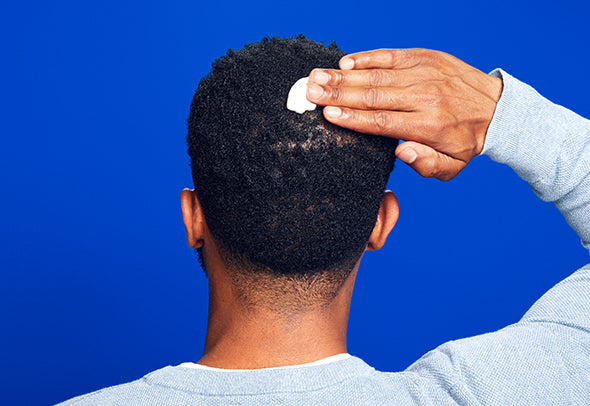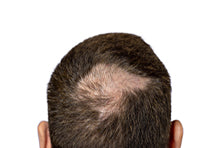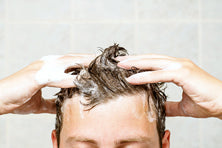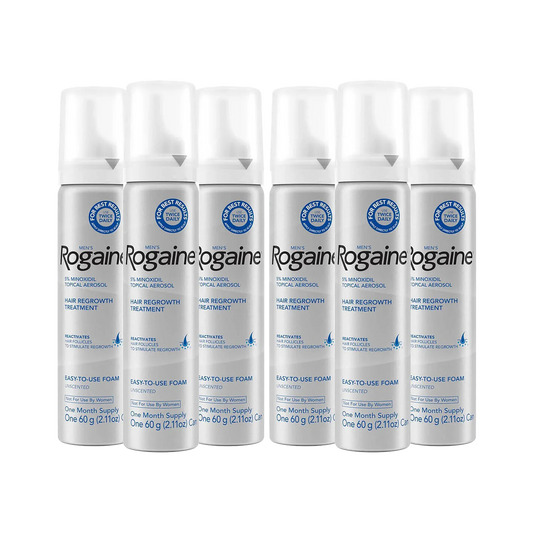While losing some hairs every day is normal, excessive shedding, thinning or balding can point to hair loss. Also known as alopecia, hair loss can be found anywhere on the body but is most common on the scalp.
The factors that could affect hair loss include genetics, lifestyle, underlying conditions and certain medications. While not all hair loss is the sign of anything more serious, it is worth looking into why you may be experiencing more hair loss than usual.
Here are some of the most common types of hair loss, what causes them, and ways you can manage excessive shedding, thinning or bald patches.
Androgenic Alopecia
Androgenic alopecia, also known as male pattern baldness and female pattern baldness, is by far the most common type of hair loss, affecting up to 50 million men and 30 million1 women in the United States. In men, hair loss is usually seen as a receding hairline in an M shape at the front of the head and/or at the crown, and it can eventually lead to baldness. Women may notice their hair thinning at their part, crown, or evenly spread across the scalp, though rarely will go totally bald.
Androgenic alopecia is a genetic condition that can start as early as teenage years, but it generally progresses slowly and can be managed with regrowth treatment options.
Alopecia Areata
Alopecia areata is an autoimmune in which the body’s immune system attacks the hair follicles, causing the hair to fall out and preventing new hairs from growing. Alopecia areata usually presents as small bald patches on the scalp or body and could eventually spread to complete hair loss.
This painless condition can affect both adults and children and is more common in people with other autoimmune conditions2. While hair loss can be sudden and there is no known cure, this type of hair loss usually responds well to regrowth treatments, especially when started early.
Telogen Effluvium
Telogen effluvium is a temporary type of hair loss that can be triggered by a stressor such as illness, childbirth, surgery or acute stress. Telogen effluvium causes more hair than the usual 10-15%3 to shift into the telogen (resting) phase of the hair growth cycle. This presents as increased shedding that is noticeable around 2-3 months after the initial stressor.
While telogen effluvium can cause the hair to feel more thin overall, it doesn’t usually lead to complete baldness. In most cases, hair will start to regrow within 6 months and can generally be expected to resolve itself4. Regrowth treatments can help boost hair growth after telogen effluvium, which can be supported by healthy lifestyle factors such as diet, sleep and stress management.
Anagen Effluvium
Anagen effluvium, also known as chemotherapy-induced alopecia, is a type of hair loss that interferes with the active growth (anagen) phase. This rapid hair loss is caused by certain cancer treatments such as chemotherapy or radiation. These cancer treatments are effective at targeting fast-multiplying cancer cells, but also affect the hair follicle in the process.
Hair loss is usually noticeable within 2 weeks of the first treatment5, but normal hair growth can be expected once treatment is complete. Hair regrowth treatments can help boost the hair once the normal growth cycle has returned.
Tinea Capitis
Also known as scalp ringworm, tinea capitis is a fungal infection of the scalp that affects both the hair follicle and the hair shaft. It can cause patches of baldness on the head that are dry, itchy and scaly. Despite the name, there are no worms involved in ringworm on the scalp, however this fungal infection is contagious and is most common in children.
Tinea capitis requires prescription antifungal medication, but hair regrowth can be expected after treatment, especially if caught early6.
Loose Anagen Syndrome
Loose anagen syndrome (LAS) a hair loss disorder that causes excess shedding of the hairs in the growth (anagen) phase of the hair cycle. The anagen hairs are poorly anchored inside the follicle, meaning they can easily and painlessly be pulled out and are more likely to fall out during day-to-day activities like washing or brushing. This condition is most common in children7, specifically girls with blonde hair, and it can give hair a “bed head” appearance or make it seem to not grow.
Loose anagen syndrome generally doesn’t require treatment and most cases are resolved by adulthood.
Trichotillomania
Trichotillomania, also known as hair-pulling disorder, is a mental condition that results in a strong urge to pull hair from the scalp, eyebrows, or anywhere else on the body. The compulsion to pull hair can feel like an automatic response, leaving bald patches over time that can cause further distress or embarrassment.
Trichotillomania is often seen alongside other disorders such as anxiety or OCD, and stress can be a trigger to pull hair8. Treatment for hair-pulling disorder may be multi-faceted, including behavioral therapies and psychotherapy. While hair loss from trichotillomania is not permanent, damage to the hair follicle can cause regrowth to be slow. Targeted treatment can help to boost hair regrowth after trichotillomania.
Hair loss can feel overwhelming and frustrating, especially if you don’t know what’s causing it. There are many different types of hair loss, so if you’re experiencing a receding hairline, patchy hair loss or hair thinning, it’s worth trying to understand why.
While hair loss can be caused by genetic, lifestyle and medical factors, the good news is that there is an effective hair regrowth treatment available. ROGAINE® minoxidil products are the first FDA-approved treatment clinically-proven to help regrow hair, and it can be a helpful treatment for many different types of hair loss.
Sources
- https://nyulangone.org/conditions/hair-loss/types
- https://www.health.harvard.edu/a_to_z/hair-loss-a-to-z
- Roland, J. (2020, September 25). Stages of hair growth plus how to maintain hair health in every stage. Healthline. https://www.healthline.com/health/stages-of-hair-growth
- Alopecia UK. Telogen Effluvium. (https://www.alopecia.org.uk/telogen-effluvium).
- Saleh D, Nassereddin A, Cook C. Anagen Effluvium. [Updated 2022 Aug 8]. In: StatPearls [Internet]. Treasure Island (FL): StatPearls Publishing; 2023 Jan-. Available from: https://www.ncbi.nlm.nih.gov/books/NBK482293/
- Al Aboud AM, Crane JS. Tinea Capitis. [Updated 2023 Apr 16]. In: StatPearls [Internet]. Treasure Island (FL): StatPearls Publishing; 2023 Jan-. Available from: https://www.ncbi.nlm.nih.gov/books/NBK536909/
- Maxfield L, Cook C. Loose Anagen Syndrome. [Updated 2022 Oct 12]. In: StatPearls [Internet]. Treasure Island (FL): StatPearls Publishing; 2023 Jan-. Available from: https://www.ncbi.nlm.nih.gov/books/NBK526030/
- Pereyra AD, Saadabadi A. Trichotillomania. [Updated 2022 Jun 27]. In: StatPearls [Internet]. Treasure Island (FL): StatPearls Publishing; 2023 Jan-. Available from: https://www.ncbi.nlm.nih.gov/books/NBK493186/













